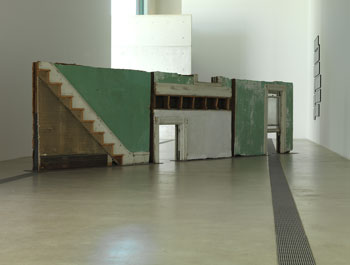Urban Alchemy/
Gordon Matta-Clark
October 30, 2009 – June 5, 2010
3716 Washington Boulevard;
St. Louis, MO 63108
314.754.1850
The Pulitzer Foundation for the Arts announces the exhibition, Urban Alchemy/Gordon Matta-Clark, on view October 30, 2009 – June 5, 2010.
The artist Gordon Matta-Clark (1943-1978) used neglected structures slated for demolition as his raw material. He carved out sections of buildings with a power saw in order to reveal their hidden construction, to provide new ways of perceiving space, and to create metaphors for the human condition. He spoke of his work as an activity that attempted “to transform place into a state of mind by opening walls.” When wrecking balls knocked down his sculpted buildings, little remained. He took photographs and films of his interventions and kept a few of the building segments, known as “cuts.” They include a section of an apartment floor (Bronx Floors: Double Doors), three parts of a house near Love Canal (Bingo), a window from an abandoned warehouse on a pier in New York City (Pier In/Out), and the rooftop corners of a house in New Jersey (Splitting: Four Corners). For this exhibition, the Pulitzer has borrowed these very cuts from The Museum of Modern Art in New York, The San Francisco Museum of Modern Art, and from the private collection of Thomas and John Solomon. The Estate of Gordon Matta-Clark and David Zwirner, New York, also lent nearly fifty photographs, while the Canadian Centre for Architecture, Montréal, provided numerous works on paper, including eleven drawings. Two of Matta-Clark’s films, Fire Child and Conical Intersect, are also on view, offering a means to understand better the performance aspect of his art.
The placement of Matta-Clark’s work in the exhibition spaces designed by Tadao Ando at the Pulitzer encourages new ways of looking at art, architecture, and the urban environment. Ando’s pristine building not only heightens the roughness of Matta-Clark’s cuts, but it will also recall the artist’s lost interventions. Both he and Ando sought to break the visual and metaphorical boundaries normally associated with the architectural “box” by allowing light to penetrate spaces in unexpected ways.
A web catalogue featuring installation views of the exhibition will be located at mattaclark.pulitzerarts.org
Reminiscent of an alchemist, Matta-Clark pursued the transmutation of a discarded object into something filled with “hope and fantasy.” He was deeply concerned with the abandonment of buildings and the fate of urban communities. He became socially and politically active during the 1970s and wrote that he focused on buildings, “for these comprise both a miniature cultural evolution and a model of prevailing social structures. Consequently, what I do to buildings is what some do with languages and others with groups of people: I organize them in order to explain and defend the need for change.”
The exhibition programming, entitled Transformation, connects the artist’s social activism to present-day St. Louis. The Pulitzer, in collaboration with the George Warren Brown School of Social Work at Washington University in St. Louis, has organized programs that build upon Matta-Clark’s desire to imbue abandoned objects, buildings, and parcels of land with new meaning. The Pulitzer hopes to help carry Matta-Clark’s legacy into the 21st century and to inspire a new generation of social activism through creative acts. An interactive web presence will reflect this community-driven programming at mattaclark.pulitzerarts.org/transformation
Through art exhibitions, programs, collaborations, and exchanges with other institutions, the Pulitzer aims to foster a deeper understanding and appreciation of art and architecture and is a resource for artists, architects, scholars, students and the general public.
The Pulitzer is open and free to the public Wednesdays from 12 p.m. to 5 p.m. and Saturdays from 10 a.m. to 5 p.m. For more information about the Pulitzer Foundation for the Arts visit www.pulitzerarts.org or call 314-754-1850.

